Welcome back to the second-to-last part of the Croatian travel diary. It's been almost half a year since we returned to Prague, yet I haven't covered the entire stay yet. With the marvelous snowy cover outside and temperatures well below zero, my girlfriend and I have the temptation to head off for skiing, perhaps in Italy. It's the best time to finish the Croatian adventure and start a winter one. Here we go!
Vítejte u předposledního pokračování mého chorvatského deníčku. Už je to sice půl roku, ale mám tu ještě pár restíků. A protože sněhová nadílka a teploty hluboko pod nulou lákají k nějakému lyžařskému výletu, pošilháváme po Itálii, je nejvyšší čas si to léto odbýt. Takže jdeme na to.
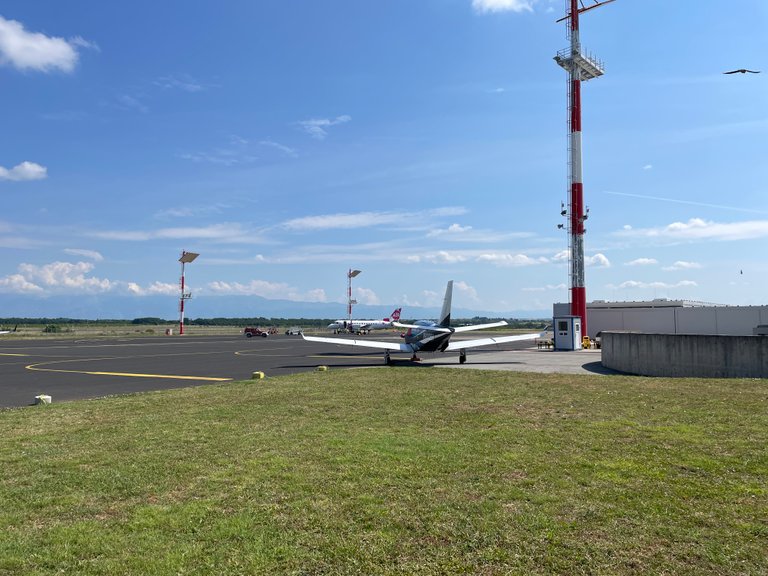
Zračna luka Zadar, the Zadar airport.
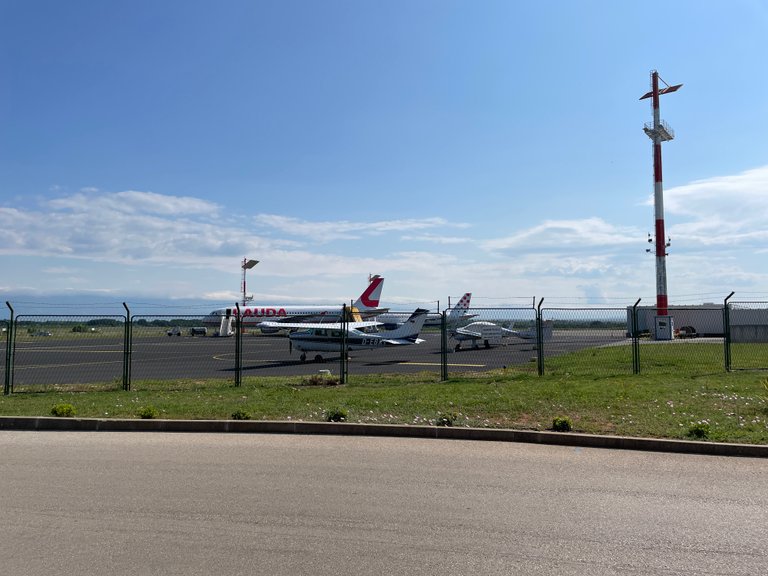
I haven't shared much about Zadar yet. With 70 thousand inhabitants, most would call it a town. It definitely has more of a town-like feeling than a city vibe. However, there's a tiny international airport just outside the city border, well-connected to various European cities. Many of the flights are operated by low-cost carriers, making it very affordable to get there. The flight tickets may even cost as little as €/$ 10 one way. So, I set a price alert, and once the prices dropped enough, we couldn't resist leaving Prague for what I call a "beach office." We chose to stay in the village of Kožino to keep our distance from the most touristy places but spent two days and some evenings in Zadar. I'd recommend renting a car at the airport. Even if you only need it to reach your accommodation, it can be cheaper than taking a cab. In fact, we rented a car for around 6 euros per day if my memory serves me well.
O Zadaru jsem toho ještě moc nenapsal. S nějakými 70 tisíci dušemi je to spíše maloměsto než město. A rozhodně má spíš maloměstskou než městskou atmosféru. Na rozdíl od klasického městečka má ovšem Zadar mezinárodní letiště. Není moc velké, ale za to má docela slušné spojení s městy po celé Evropě, Prahu nevyjímaje. Velkou část letů obstarávají nízkonákladovky, a tak letenku koupíte i za nějaké tři stovky, když víte, jak na to. Třeba @kap1 toho na konci léta také využila. My jsme sice na naší beach office pobývali trochu stranou turistického ruchu ve vesnici Kožino, ale v Zadaru jsme strávili dva dny a několik večerů. V každém případě doporučuju půjčit si na letišti auto, i kdybyste ho potřebovali jen na cestu do ubytování. Může to vyjít levněji než taxi nebo autobus do města, naše jsme si půjčovali za nějakých šest euro na den.
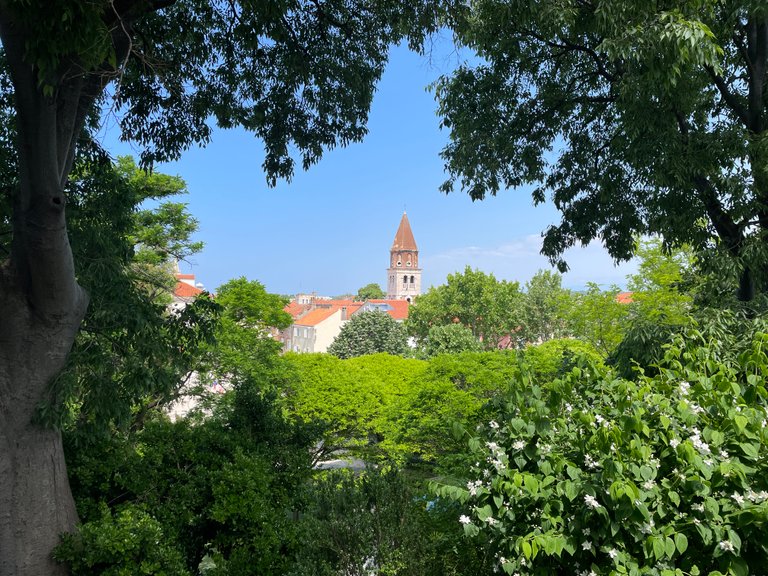
Zadar is one of the oldest continuously habited towns in Croatia, with a history dating back to 48 BC when the Romans established it as Colonia Iulia Iader. The old town stretches across a peninsula secluded from the mainland by the surprisingly green Vladimir Nazor Park. This park is situated on the grounds of a defunct Forte Fortress, retaining traces of its defensive walls and turrets. On the first day of our Croatian stay, we parked our rented car just outside the old city walls and entered through the park.
Zadar je jedno z nejstarších trvale osídlených měst v Chorvatsku. Už v roce 48 před Kristem ho založili Římané coby Colonia Iulia Iader. Staré město se rozkládá na poloostrově, který je od pevniny oddělený až překvapivě zeleným parkem Vladimira Nazora. Ten je na místě bývalé pevnosti Forte, jejíž pozůstatky na vás stále tu a tam vykouknou. Třeba kusy hradeb nebo bývalé věže. První den našeho pobytu v Chorvatsku jsme zaparkovali kousek od parku a právě skrze něj vešli do města.


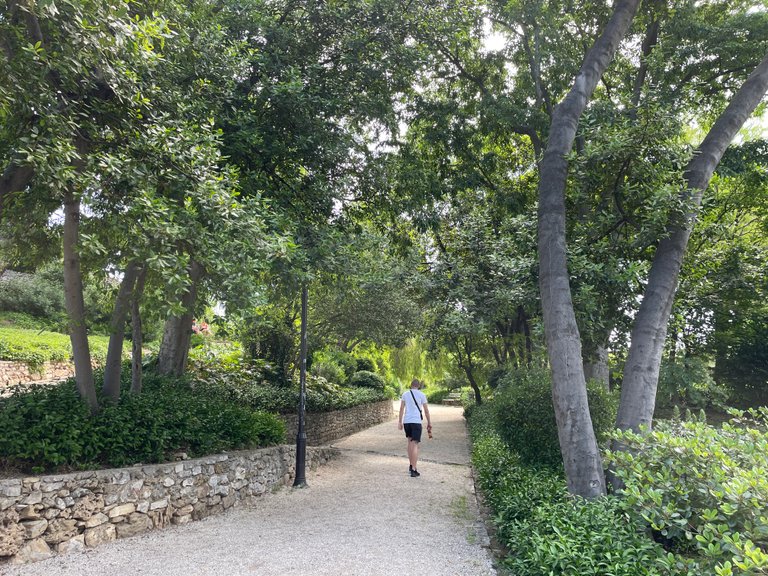
The old town had two gates, and the old Zadarians didn't show much creativity in naming them. This one is the Land Gate (Kopnena vrata), while the other, situated on the Northeastern edge of the peninsula, is called the Sea Gate. Yes, it used to serve those arriving by sea. The dry moat that used to separate the city and fortress walls has been backfilled, so now you walk over it directly into the old town passing over the gate.
Starý Zadar míval dvě brány, a Zadarští při jejich pojmenovávání nebyli moc kreativní. Tohle jsou Kopnena vrata, česky Pevninská brána. Ta druhá se jmenovala Mořská brána a je na severovýchodním kraji poloostrova. Ano, tudy procházeli ti, kdož do Zadaru připluli po moři. Mezi městskými hradbami a hradbami pevnosti býval příkop, ten je ale dávno zasypaný, a tak se dá přejít z parku přímo do města a na bránu koukat svrchu.
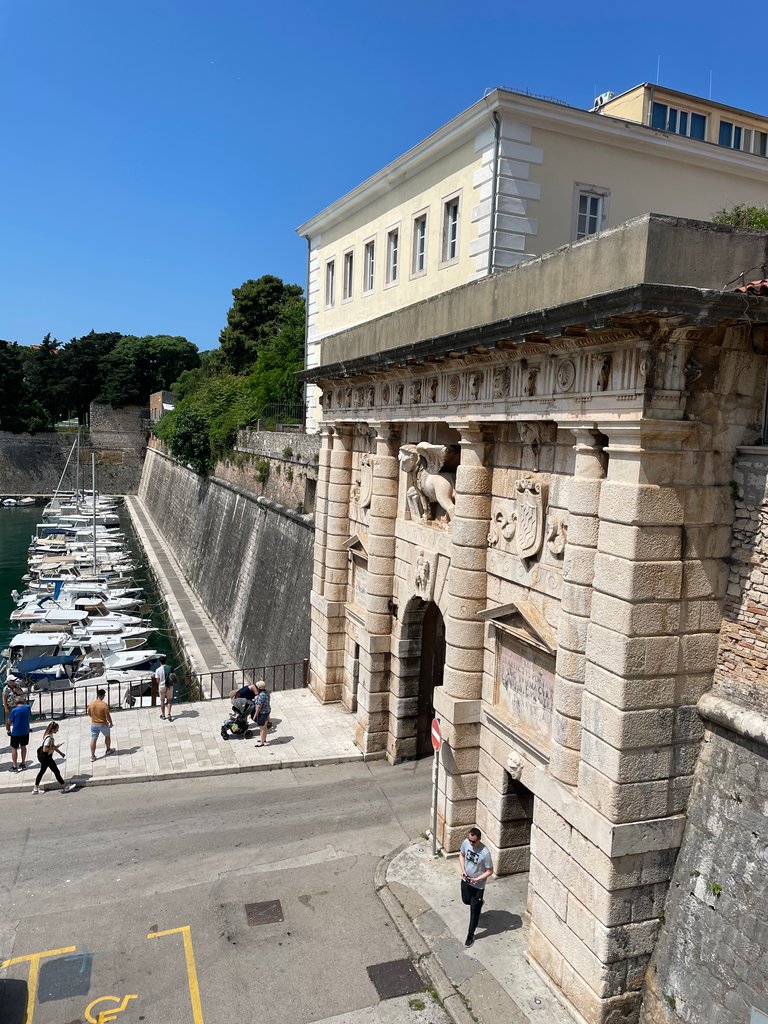
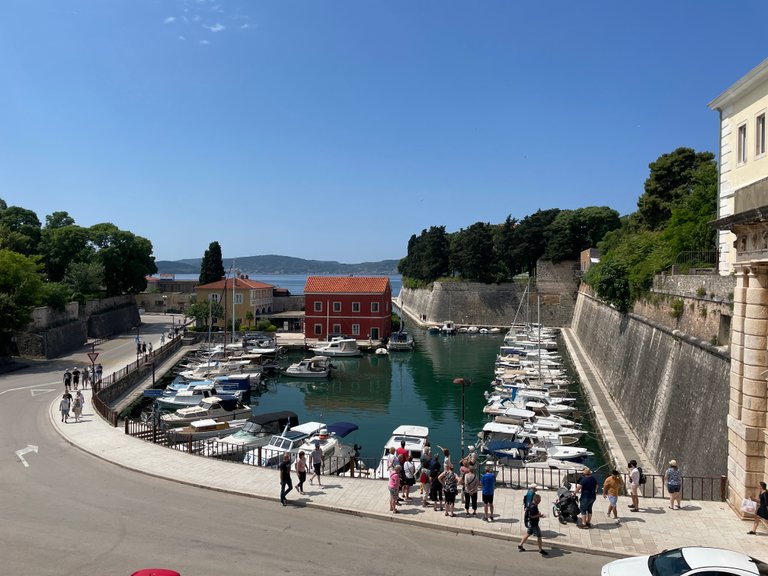
This is Široka Ulica, literally translated as Broadway. It is the main and most representative avenue, lined with various tourist traps. Besides the generic crappy souvenirs, one might find some enticing pastries or ice cream there. I am not about to recommend any specific places there, though, as I avoided eating around here. If you insist on dining in Zadar Old Town, try Pizza Zizou, where the locals go. It is a takeaway place, but the pizzas were great.
Tohle je Široka Ulica, hlavní a nejnačančanější ulice na starém městě. Samozřejmě je na ní spousta turistických pastí a pastiček. Kromě klasického suvenýrového smetí třeba lákavě vypadající pekárny a zmrzlinárny. Žádnou vám nedoporučím, vyhnul jsem se jim obloukem. Ale pokud se chcete na starém městě dobře najíst, zkuste Pizzu Zizou, kam chodívají i místní. Je to bistro, takže pizza jen sebou, ale jídlo mají skvělé.


Široka Ulica leads to the oldest square in Zadar, famous for its historical churches and the remnants of an ancient Roman forum. Regarding the forum, it holds the title of the largest one in Croatia, with an impressive area of 95m by 45m. If you happen to be a historian or an architecture pundit, you might discern remnants of a portico with a colonnade and a large temple. As for me, I see stones arranged in a manner that resembles buildings. Some of them are adorned with rather eerie faces.
Širokou ulicí dojdete až na nejstarší náměstí, které je lemováno historickými kostely. A jsou na něm i pozůstatky římského fóra. To bývalo se svou úctyhodnou rozlohou 95x45 metrů největší v Chorvatsku. Pokud jste historik nebo architekt, možná tu uvidíte pozůstatky portikové kolonády a velkého chrámu. Já v tom vidím tak maximálně kameny vyskládané do tvarů základů nějakých budov. Některé jsou ozdobené trochu děsivými obličeji.
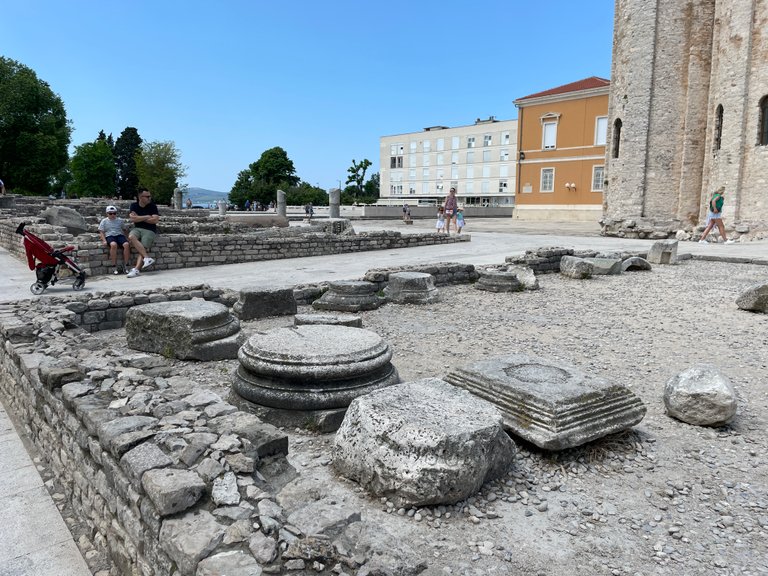
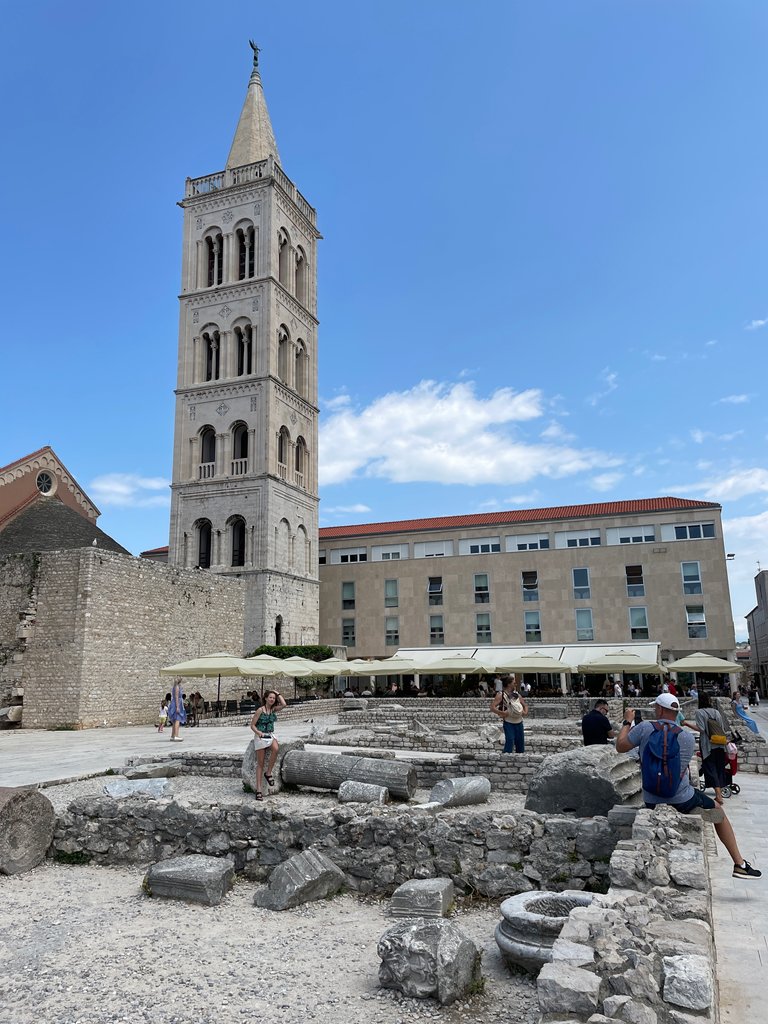

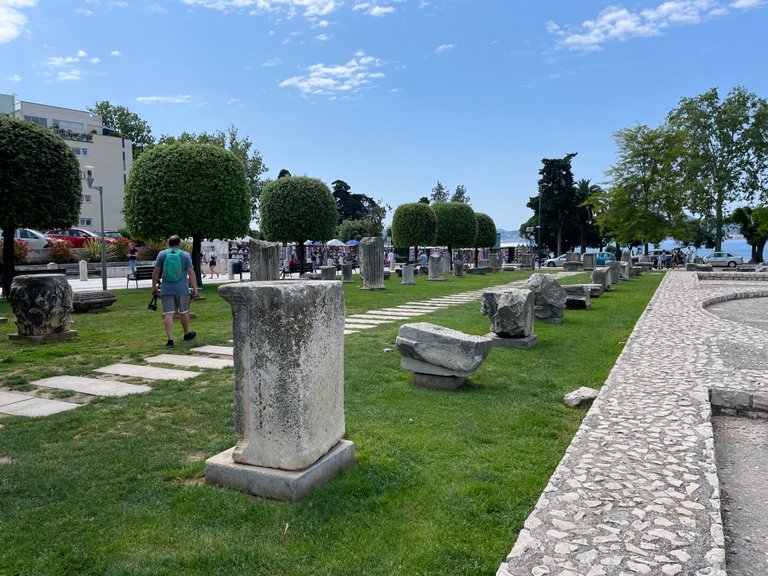
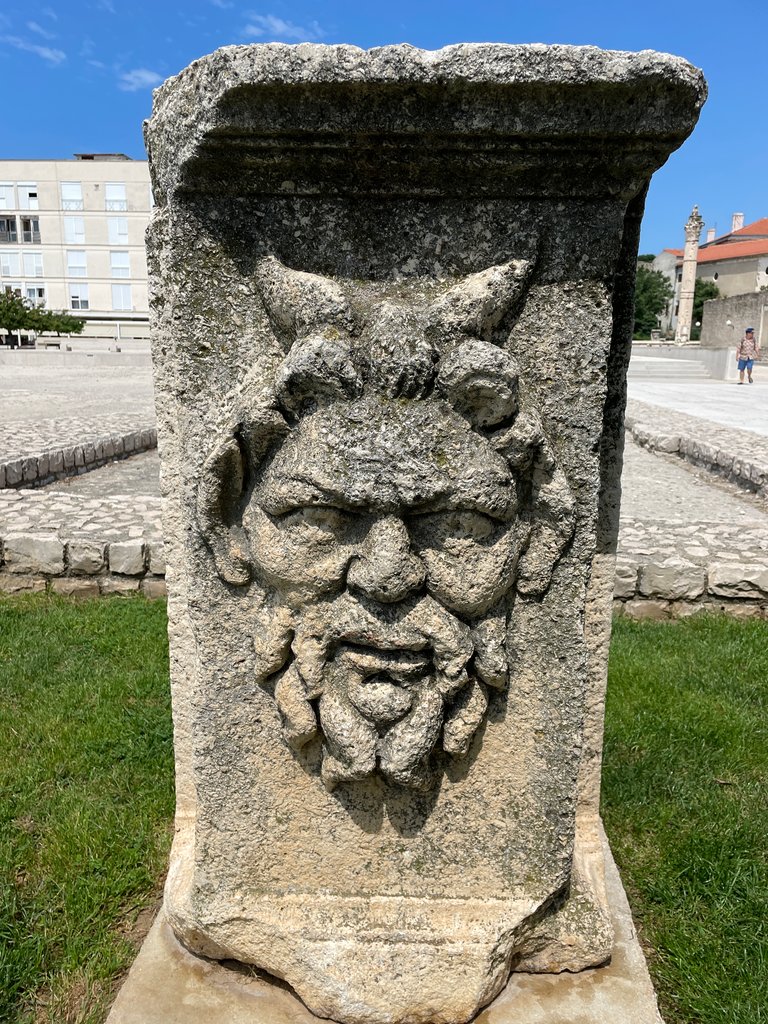
The slender bell tower belongs to the Cathedral of St. Anastasia, a Romanesque church dating back to the 12th century. Interestingly, the tower is relatively contemporary, completed only in the 1890s. Adjacent to it is the Pre-Romanesque Church of St. Donatus, built in the 9th century, which steals all the thunder here, arguably standing as the most notable Christian sacral building in the county. I couldn't resist the temptation to enter and climb up to its magnificent dome.
Štíhlá zvonice patří románské katedrále Sv. Anastázie z 12. století. Ale věž sama je relativně nová, dokončena byla až v devadesátých letech devatenáctého století. Hlavní pozornost na sebe ovšem strhává sousední předrománský kostel sv. Donáta z 9. století, o kterém se dočtete, že jde o nejvýznamnější křesťanskou stavbu široko daleko. A tak jsem nemohl odolat a vystoupal do jeho dómu.

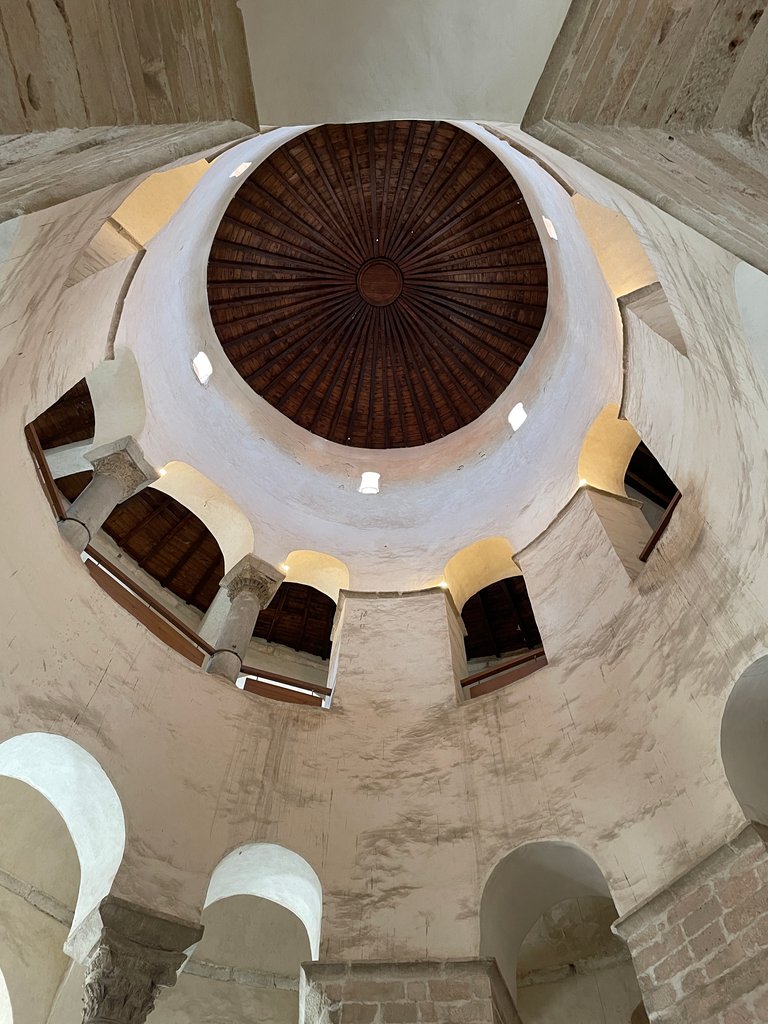
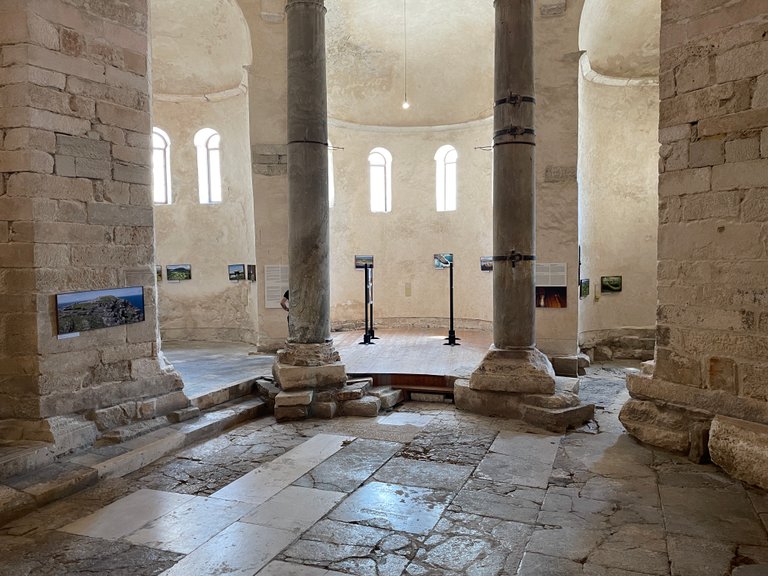
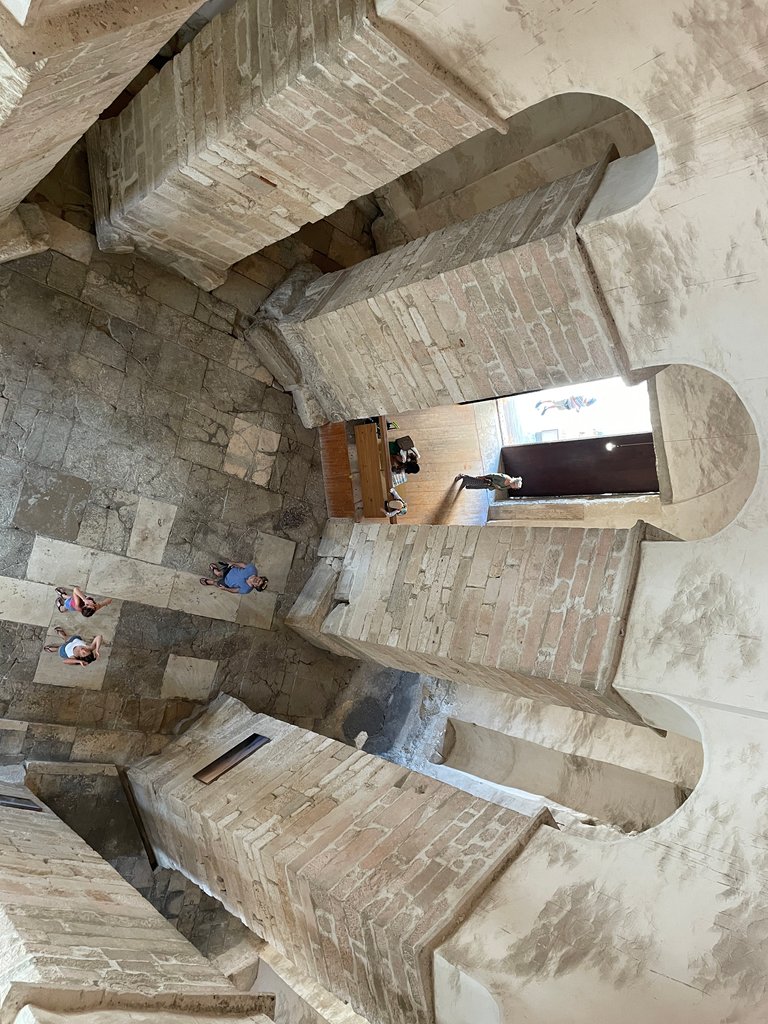
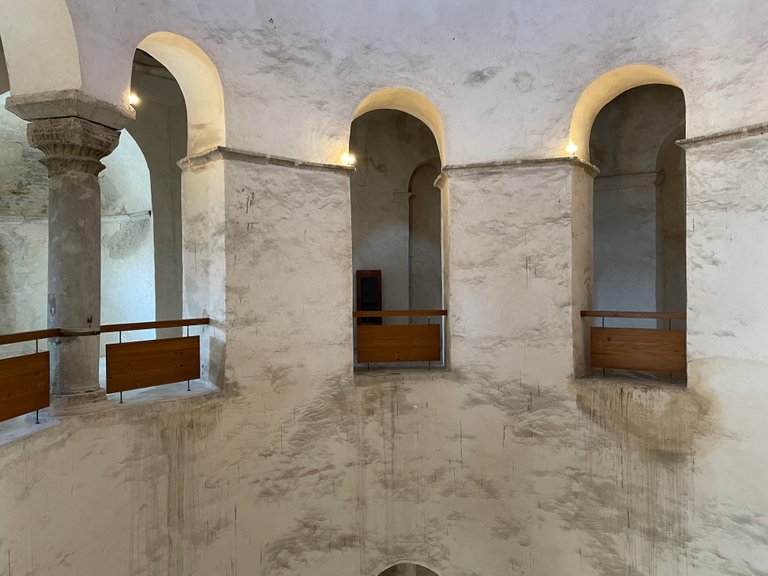

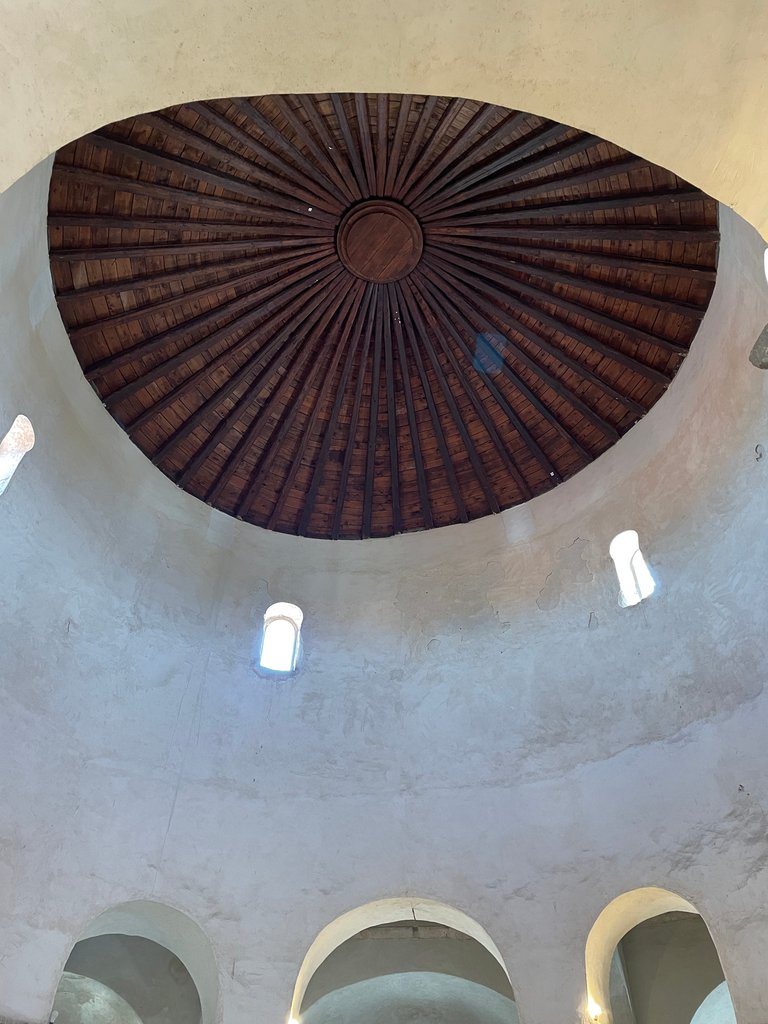
Here we have the Church of St. Mary, a Benedictine monastery dating back to 1066. Its most distinctive feature is the Renaissance-style portal from 1507. Unfortunately, this church suffered significant damage during World War II, so what you see today is mostly a faithful contemporary replica.
A tady je kostel Sv. Marie, benediktinský klášter z roku 1066. Jeho nejzajímavějším prvkem je renesanční portál z roku 1507. Ale ve skutečnosti jde o věrnou repliku původního portálu, kostel byl totiž těžce poškozen za druhé světové války.

Enough with the old buildings; let's head to the sea! After all, that's why people come to Croatia. If you grabbed a pizza at Zizou, as I suggested, you might want to enjoy it at the world-renowned Sea Organ. This unique breakwater resonates with waves, producing sounds depending on their frequency, direction, and height. While its visual appearance may not be particularly striking – it looks like huge concrete stairs to the sea – the experience can be genuinely touching.
Ale dost bylo historických budov, pojďme k moři. Kvůli němu se přeci jen do Chorvatska jezdí, ne? Pokud jste dali na mé rady a nesete si v ruce pizzu od Zizou, můžete si ji vychutnat třeba na známých Mořských varhanách. To je ve skutečnosti unikátní vlnolam, který rezonuje a vydává zvuky podle toho, jaké jsou zrovna na moři vlny. Po vizuální stránce to není žádná hitparáda, vypadá to trochu jako velké betonové schody do moře, ale jako zvuková kulisa je to hodně zajímavé.
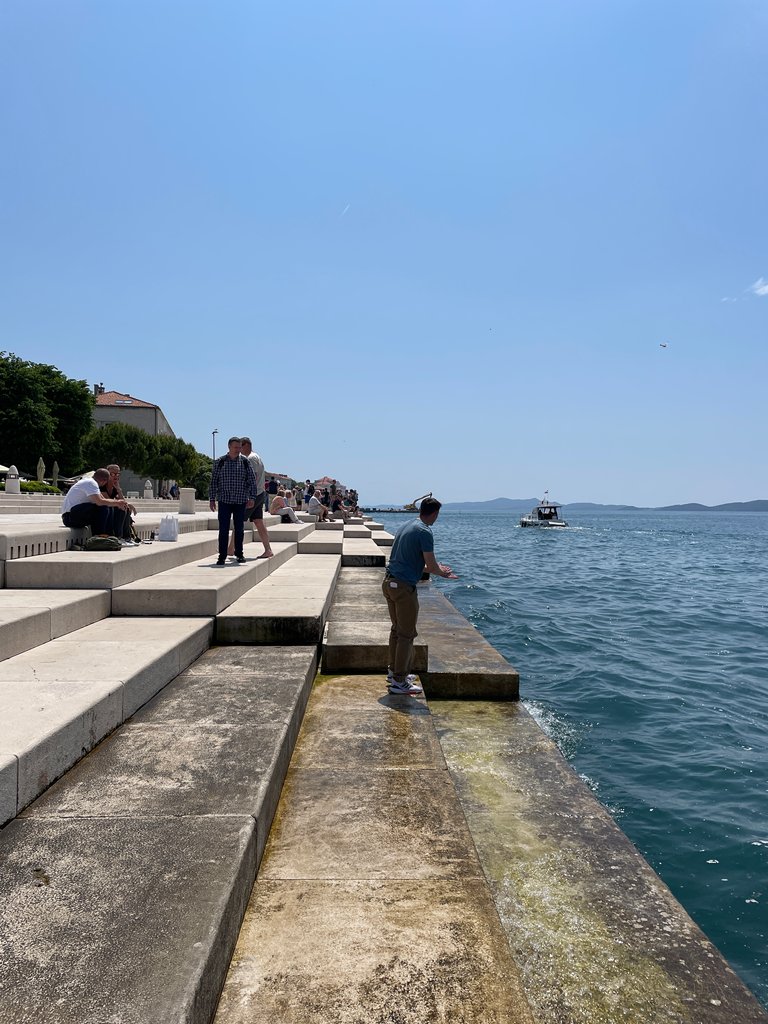
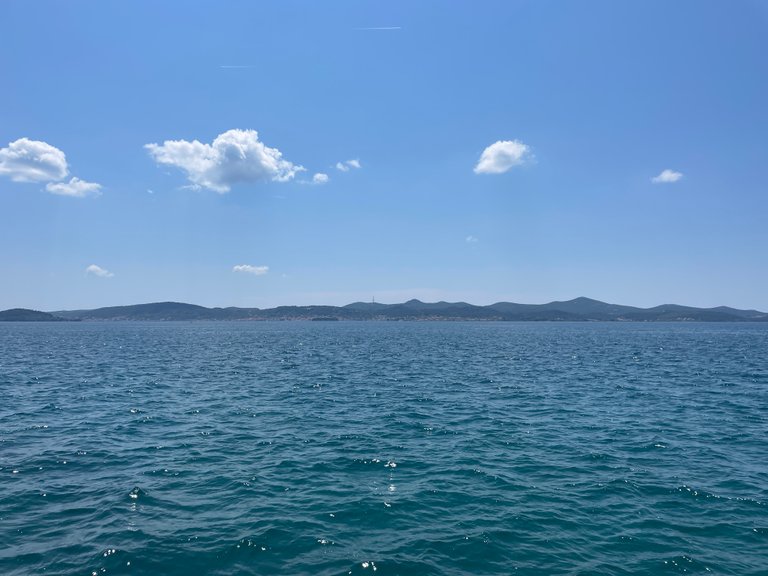
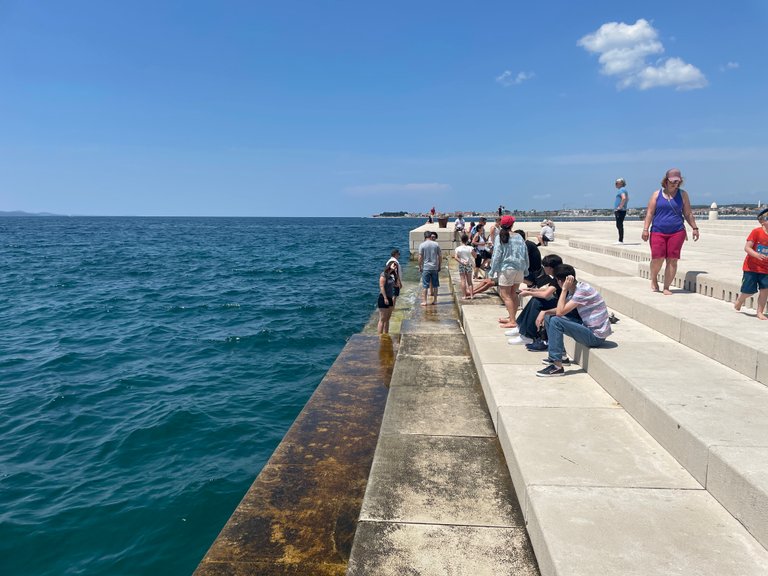
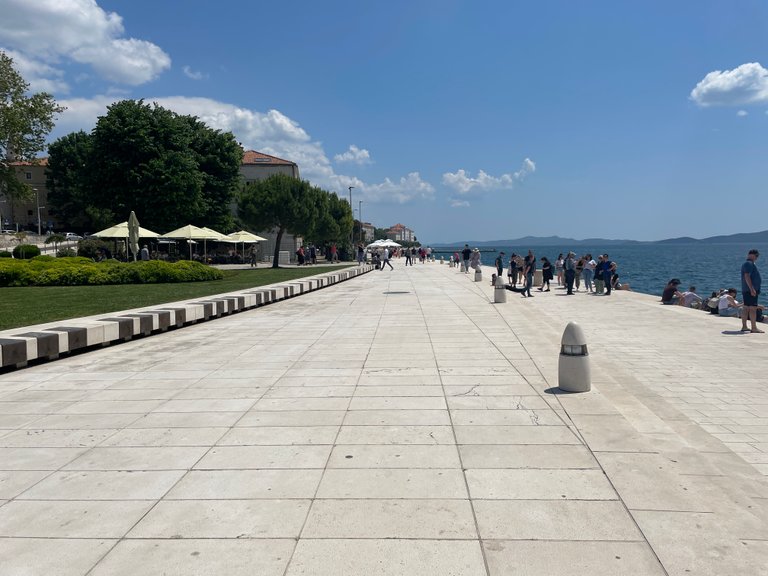
A stone's throw away lies another piece of art, this time purely visual. It's called Pozdrav Suncu, Greeting to the Sun. In brief, it's a 22-meter diameter circle with photovoltaic solar modules that charge during the day and emit light during the evenings. Unfortunately, we weren't around after dark. In daylight, it appears as a common photovoltaic solar plant.
Jen kousek od varhan je další umělecká instalace, tentokrát výhradně vizuální. Jmenuje se Pozdrav suncu, tedy slunci. Jde o kruh fotovoltaických solárních panelů s poloměrem 22 metrů. Panely se přes den nabíjejí a večer svítí. Za tmy jsme tam bohužel nebyli, a ve dne vypadá Pozdrav jako klasická solární elektrárna.

With all that blue sea around, I imagine you might be tempted to take a dip. Although I generally advise against city beaches, there are places to swim in Zadar. You can take a leisurely stroll along the reconstructed promenade of the old town, eventually reaching the Land Gate. By the way, the inner portal looks way less impressive than the outer one.
Ze všeho toho mořského blankytu kolem as zatoužíte po koupání. I když městské pláže bývají nic moc, i v Zadaru si můžete zaplavat. Stačí se projít po zrekonstruované promenádě a projít Pevninskou bránou. Ta je mimochodem zevnitř mnohem méně reprezentativní než z vnějšku.

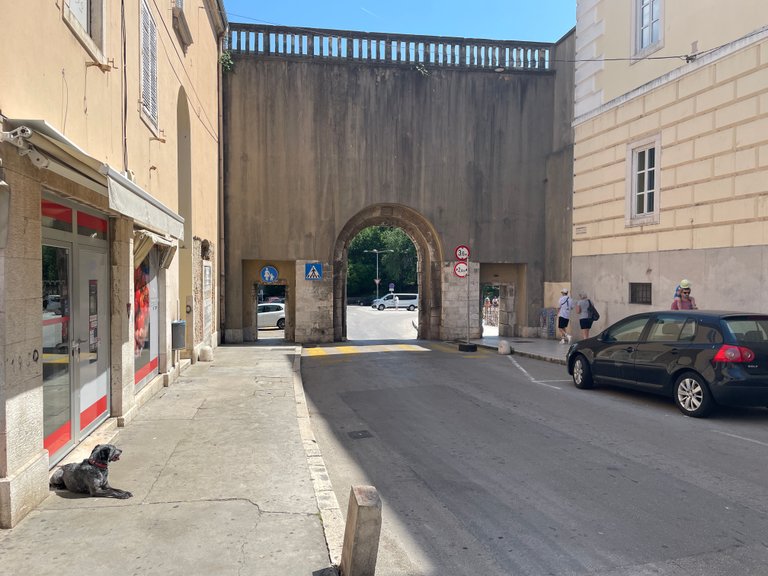
A strip of characteristical Croatian beaches, the stony ones, begins just a few hundred meters from the gate. It takes about 20 minutes to reach them from the Sea Organ. Since we were there before the peak tourist season, they weren't crowded, and one could actually take a dip there.
Jen pár set metrů za branou začíná pás typických chorvatských kamenitých pláží. Od varhan to k nim trvá asi dvacet minut. Protože ještě nezačala turistická sezona, nebyly tak úplně přeplněné, takže se dalo i vykoupat.

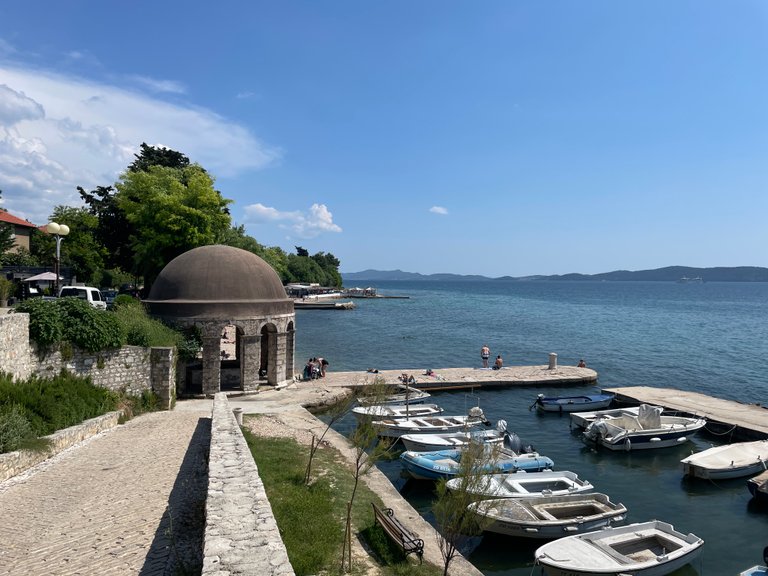
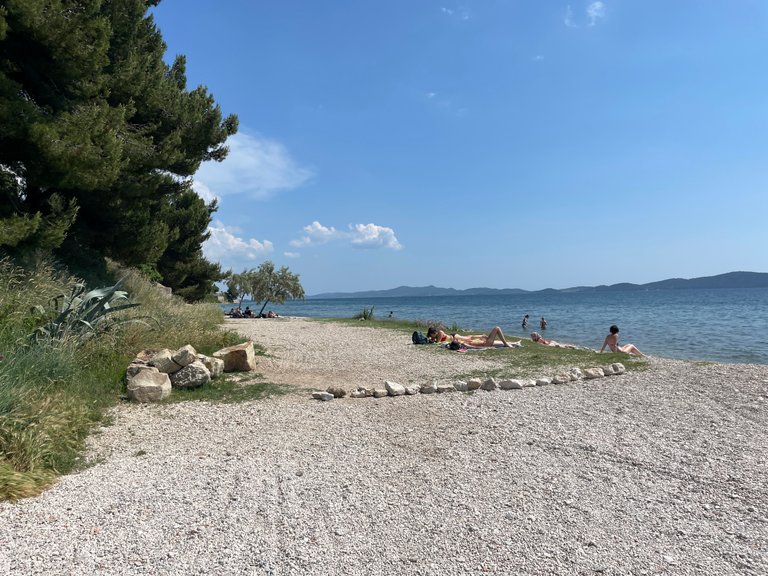
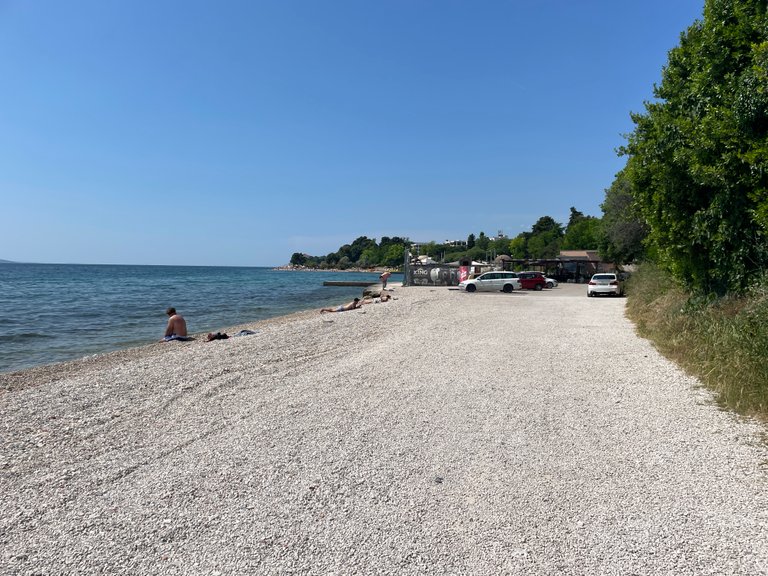
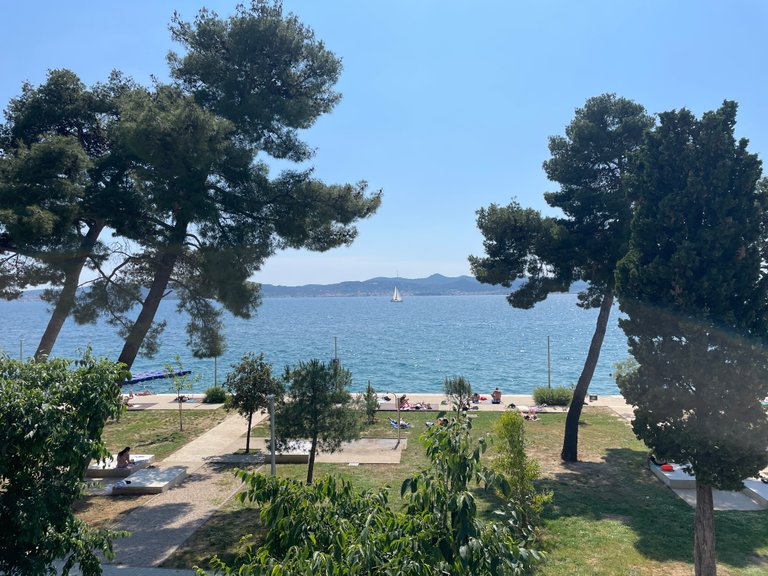
That wraps up Zadar. Stay tuned for my final Croatian post!





